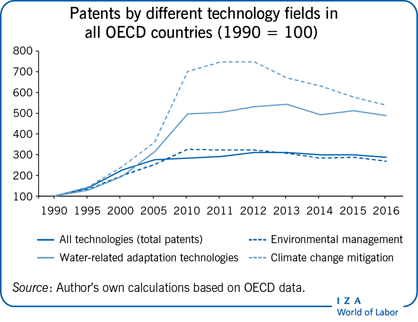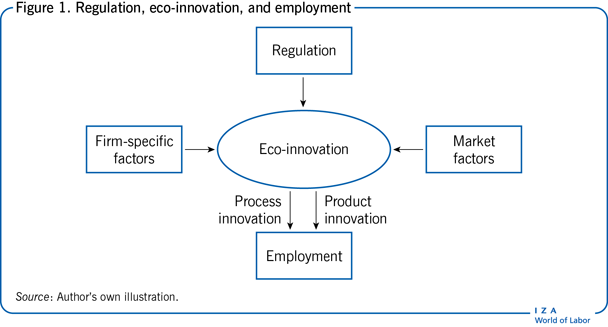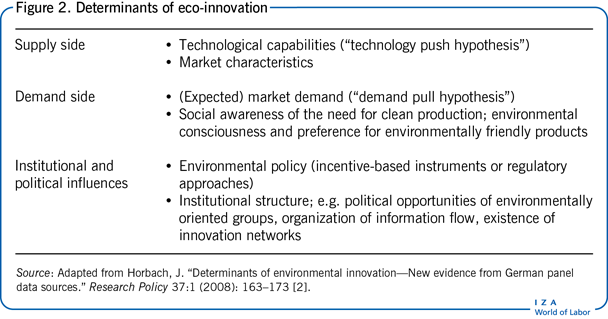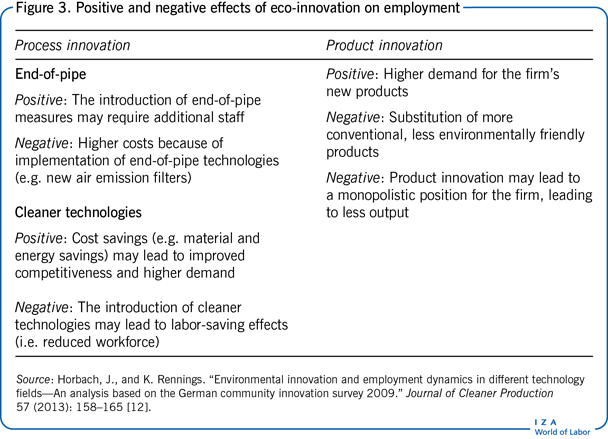Elevator pitch
New environmental technologies (environmental/eco-innovations) are often regarded as potential job creators—in addition to their positive effects on the environment. Environmental regulation may induce innovations that are accompanied by positive growth and employment effects. Recent empirical analyses show that the introduction of cleaner process innovations, rather than product-based ones, may also lead to higher employment. The rationale is that cleaner technologies lead to cost savings, which helps to improve firms’ competitiveness, thereby inducing positive effects on their market shares.

Key findings
Pros
Environmental regulation can help firms overcome informational, organizational, and coordination-related problems, leading to more eco-innovation activities.
Regulation-induced environmental process innovations can improve firms’ competitiveness and increase market shares, which may lead to more employment.
Skill-based analyses show that many green technologies require high qualifications thus leading to wage premiums compared to non-green jobs.
Environmental product innovations may lead to first-mover advantages for the respective firms.
Cons
Empirical evidence suggests that net employment effects of environmental and energy policies are small.
Regulation-induced eco-innovation may lead to a crowding out of other innovation activities, thus reducing employment in the affected fields.
Regulation measures are only successful for the realization of eco-innovations if they are well coordinated with other policies.
End-of-pipe technologies, such as additional filters or sewage works, may reduce employment due to higher production costs.
Author's main message
Regulation is crucial for the introduction of eco-innovations, but there are other important determinants, such as cost savings and market success. While employment effects are not the primary focus of these activities, they should be viewed as potentially significant side-effects. Empirical studies show positive but small impacts on employment resulting from environmental product innovations and the introduction of cleaner technologies within firms. Policymakers have to be aware that environmental policy primarily aims at reducing environmental impacts and resource use without expecting a significant boost to economic growth.
Motivation
The political debate revolving around whether environmental regulations are job creators or job killers is quite controversial. So, what is the more realistic scenario? Eco-innovations (a synonym for environmental innovation) lead to a reduction in material and energy use, thereby reducing environmental impacts. These types of innovations may therefore help to remedy the negative external environmental effects most commonly associated with economic activities. In most cases, these negative external effects have to be internalized by regulation measures; as such, the role of regulation as a determinant of eco-innovation is crucial.
The economic effects from eco-innovation gained increasing attention with the publication of the highly cited Porter hypothesis, which suggests that environmental regulation leads to positive effects on the innovative behavior and competitiveness of regulated firms. The application of empirical methods is necessary to gain a thorough understanding of the impact on employment that comes from eco-innovation activities, particularly because it must be considered that eco-innovation may also destroy jobs. Furthermore, regulations are not randomly assigned across industries or sectors, making the identification of causal effects even more difficult. In areas and technology fields where eco-innovations do create jobs, analysis of their determinants is crucial, as this provides information that improves the design and the consistent mix of political measures.
The main determinants of eco-innovations are shown in Figure 1. Besides regulation activities, firm-specific factors such as managers’ “greenness” and market factors (i.e. demand for green products) trigger eco-innovations. The resulting employment effects depend on the nature of eco-innovations, whether they are process- or product-oriented.

Discussion of pros and cons
Definition and determinants of environmental innovation
Environmental innovation has been defined in the literature as follows: “Eco-innovation is the production, assimilation or exploitation of a product, production process, service or management or business method that is novel to the organisation (developing or adopting it) and which results, throughout its life cycle, in a reduction of environmental risk, pollution and other negative impacts of resource use (including energy use) compared to relevant alternatives” [1], p. 7.
All innovations that lead to positive environmental effects are defined as environmental innovations. It may thus be possible that innovations are defined as “green” even if the respective innovation activities did not aim at improving the environment. For example, the re-design of a production process aimed at reducing labor costs may also lead to energy savings, thereby fitting the definition of an eco-innovation.
Following the general innovation theory, technology push and market pull factors are crucial for explaining the realization of innovation activities [2]. In addition, the factors listed in Figure 2 are also important determinants for eco-innovations. In contrast to other innovations, eco-innovations may depend on the environmental consciousness of consumers and firms, denoting an environmentally oriented demand pull effect. Furthermore, cost savings may be more important for eco-innovations compared to other innovations because they are often linked to a reduction in material or energy consumption.
The role of regulation in eco-innovation
Regulation is crucial for the realization of eco-innovation activities. This is the case because there may not be any clear economic incentives to develop new environmentally benign products and processes. From a traditional point of view, environmental policy imposes additional production costs, potentially reducing the international competitiveness of a firm [3]. For end-of-pipe pollution abatement technologies in particular, which often require additional and “unproductive” equipment, this argumentation seems to be justified. “In this static world, where firms have already made their cost-minimizing choices, environmental regulation inevitably raises costs and will tend to reduce the market share of domestic companies on global markets” [4], p. 97. However, in contrast to that view is the issue of possible innovation offsets; that is, improved regulation-induced environmental performance may be accompanied by material and energy savings. These cost savings lead to increased competitiveness, so that additional production costs may actually be over-compensated for as a result of the environmental measures taken. Regulation might provide signals that reduce information deficits about the incomplete utilization of resources or the minimizing of discharges [4]. As an example, mandatory environmental audits push firms to search for causes of high energy consumption, and presumably to address said causes, if feasible.
From an international perspective, new technologies resulting from regulation-induced eco-innovations may lead to first-mover advantages for regulated firms and their related suppliers in the value chain. A good example is the success of Danish wind turbine producers. Early political support led to the establishment of a successful wind energy industry, which became one of the successful first movers on an international scale. The Porter hypothesis questions a firm's ability to maximize profit, stating that so-called “present-biased managers” will postpone eco-innovations because the associated costs must be paid immediately, but the benefits only appear in the long term [3]. Such long-term payoff has certainly been the case when it comes to the Danish wind turbine industry.
It is important to mention that not all types of environmental regulations lead to innovation offsets [3]. For instance, regulations that explicitly require the implementation of specific end-of-pipe technologies, such as filters, will certainly raise production costs. In general, the empirical literature shows that market-based instruments, such as eco-taxes or tradable permits, are more likely to trigger eco-innovation compared to technology-based standards [5]. For example, the introduction of the tradable permit system for sulfur dioxide emissions in the US led to improved removal efficiency compared to the old technology-based regulatory system [5]. Another example shows that price-based policy had a positive and significant influence on innovations related to solar, biomass, and waste energy [5].
A new strand of literature analyses the role of policy mixes for sustainable innovations [6]. As the determinants of eco-innovations are complex (Figure 2), including technology push, demand pull, and systemic concerns, the interaction of different policy instruments has to be considered. An empirical analysis for the offshore wind sector in Germany shows that an inconsistent policy mix strongly influences adoption decisions [6].
Empirical evidence of regulatory effects on eco-innovation
Leading empirical studies confirm regulation's role as an important determinant of eco-innovation. This phenomenon is known as the “regulatory push/pull effect” [7]. In the following, “stylized facts” derived from this literature are briefly summarized. Unfortunately, because of the lack of adequate data, most studies are not based on experimental or quasi-experimental designs, where the stringency or the choice of different environmental regulations vary across otherwise similar firms or industries.
A study from 2003 analyzes the role of environmental regulation for eco-innovation based on a patent analysis for US manufacturing industries from 1983 to 1992 [8]. Pollution abatement expenditures serve as an indicator for policy stringency. Using panel data models, the authors find that abatement expenditures were positively correlated to environmental innovation. Alternate patent studies also show that innovation decisions were mainly driven by regulation activities.
The effects of regulation are shown to vary between different environmental technology fields. For instance, end-of-pipe technologies are mainly triggered by regulation, whereas cost savings and environmental management systems seem to be more important for promoting cleaner technologies. Furthermore, regulation and cost savings were identified in a study based on panel data for Germany from 2001 to 2004 as the main determinants for eco-innovation [2]. However, another study by the same author, also using German data of the Community Innovation Survey in 2009, shows that the influence of regulation varies significantly for different environmental technology fields. Whereas current and expected government regulations have a particular effect on air quality, water, or noise emissions, hazardous substances treatment, and the recyclability of products, they are less important for material and energy savings.
The Porter hypothesis tends to be confirmed with respect to innovations that improve resource efficiency, whereas end-of-pipe measures seem to reduce firm profitability. A 2013 study tests different variants of the Porter hypothesis using an OECD database for seven countries [3]. This analysis supports the so-called “weak version” of the Porter hypothesis, which says that environmental regulation stimulates eco-innovations. The strong version, postulating that regulation-induced cost savings must over-compensate the compliance costs, is however not supported [3]. The impact of different policy instruments on renewable energy technologies is also analyzed in a study from 2010 [5]. Based on a patent analysis using panel data for OECD countries from 1970 to 2003, the authors show the high importance of feed-in tariffs for solar energy, whereas this policy instrument does not promote more cost-competitive technologies, such as wind power.
Most of these studies concentrate on the effects of environmental regulation with respect to the directly regulated firms. However, an overall assessment of the effects of environmental policy would require the analysis of additional effects and channels. One such study analyzes indirectly induced innovation in regulated and unregulated firms resulting from regulation-induced costs by evaluating the impacts from higher output prices and knowledge spillovers. The results ”… suggest that indirect effects of regulation on innovation are at least as large as commonly estimated direct effects” [9], p. 1.
A further strand of the empirical literature analyzes whether regulation-induced environmental innovation efforts lead to a crowding out of other innovation activities. According to a study based on the Community Innovation Survey for Germany in 2009, the results of treatment effects models indicate that a small crowding out of the firms’ in-house research and development (R&D) indeed exists [10].
Finally, many studies show that environmental management tools, specialized organizational arrangements (e.g. dedicated R&D department, person responsible for environmental concerns), and cost savings as motivation are very important for the introduction of cleaner technologies but not for end-of-pipe measures. The important role of market demand for the realization of eco-innovation is also confirmed by many other empirical analyses. For instance, customer benefits are important for the introduction of environmental innovations if the environmental impact of a product denotes a higher added value for the customer [11]. This may be problematic for green electricity, for example, but environmental product innovations such as food or baby clothes may lead to substantial customer benefits.
Eco-innovation and employment
The relationship between (eco-)innovation and employment within a firm strongly depends on the nature of innovation, especially with respect to process and product innovation (Figure 3). Concerning process innovations, a further distinction between end-of-pipe and cleaner technologies is important. In general, process innovations may induce negative employment effects if they are accompanied by higher labor productivity, assuming a steady output. In other words, given the same output quantity, a more efficient process will generally reduce the associated labor requirements, thereby eliminating the need for some jobs.
Production-integrated cleaner technologies, such as heat recovery systems or solvent-free varnishing processes, often lead to less pollution or material or energy savings. These cost savings may be accompanied by an increase in total factor productivity (labor, capital, and energy) of the firm. A valid question then becomes: do cost saving process innovations also affect the share of labor in the corresponding production process?
Higher capital efficiency induced by the adoption of cleaner technologies may lead to a substitution of labor by capital (i.e. increased use of automated processes) because labor becomes relatively less valuable to the firm. This trend also leads to a decrease in wage levels, which may help to reduce the overall negative employment effects. Cleaner technologies may also be realized through organizational innovations and/or the improvement of human capital. In this case, the cost saving effects may be achieved by taking on more specialized and highly qualified employees who are able to reorganize production processes in a more resource-efficient way [12]. In sum, depending on the specific case, a higher, constant, or lower labor share may result. In any case, an increase in total factor productivity caused by the introduction of cleaner technologies strengthens the competitiveness of firms and thus may lead to positive employment effects [4]. In case of lower labor share, higher demand (e.g. resulting from first-mover advantages) may compensate for employment losses. In case of higher labor share, on the other hand, the competitiveness effect might further strengthen employment gains [12].
In contrast, end-of-pipe process innovations, such as the introduction of additional filter systems to the production process, require an alternative viewpoint. The construction, installation, and maintenance of a filter system may require additional staff, which would be associated with positive direct employment effects. The indirect effect, however, may be negative, since end-of-pipe technologies induce higher costs and thereby lower firm competitiveness. These factors can lead to a decline in output and in employment [12]. Given these mixed results, the effects of environmental process innovations on employment remain ambiguous and an ongoing empirical question.
The employment effects of environmental product innovations are also theoretically unclear. On the one hand, product innovations may induce additional demand if they create completely new markets or if they provide substitutes for competitors’ products. In this case, the effect on employment at the firm level is positive. At the macroeconomic level, the effect is not clearly determined and depends, among other things, on the labor intensity of the substituted products. Negative employment effects from product innovations may also arise because the introduction of a new product may provide the firm with a monopolistic position, leading to a reduction of overall output [12].
There are many empirical studies focusing on the general link between innovation and employment, but relatively few that focus on the specificities of eco-innovations. The general innovation studies mostly find positive effects of product innovations on labor demand, whereas the results for process innovations are mixed [13]. Due to data problems, analyses on the employment effects of environmental innovations are still rare. Most of these analyses do detect slightly positive effects of eco-innovations on employment [14]. One such study based on an econometric analysis with data from the German part of the Community Innovation Survey 2009 shows that the introduction of cleaner technologies as process innovations is connected with higher employment growth [12]. Using quantile regression methods, a recent study for Germany based on the Community Innovation Survey 2014 shows that innovations related to the circular economy, as a subset of eco-innovations, trigger employment and turnover growth [14]. The positive influence of environmental product innovations on employment is confirmed in further studies. Based on survey data of the Community Innovation Survey 2008, both environmental and non-environmental product innovations are shown to trigger employment, but non-environmental product innovations are more likely to increase employment.
Another recent study develops a new measure of green employment based on the task content of occupations [15]. For US local labor markets between 2006 and 2014, the authors show that environmental regulation is a significant driver of green employment dynamics, but the local endowment of green knowledge and resilience seems to be even more important. As the top green technology fields are mostly high-tech, it is not surprising that the study finds green jobs lead to a 4% wage premium compared to other jobs.
In sum, the results from empirical studies suggest that environmental and energy policy can have positive net effects on employment. However, it seems clear that environmental policies should not be counted on to provide major employment growth at the macro level.
Limitations and gaps
Empirical analysis of the relationship between eco-innovation and employment is restricted by data availability. There are few panel data studies available and questions on environmental innovation, in most cases, involve point-in-time data.
In some cases, further data restrictions result from the lack of reliable indicators for environmental regulation, particularly in studies based on survey data. Indicators such as investment in abatement technologies were deemed useful when end-of-pipe technologies that lead to higher costs for the respective firms were the norm. In those cases, the assumed link to regulation activities seemed plausible. However, the growing importance of so-called cleaner technologies signifies that investment in environmental technologies may be driven by other motivations, such as cost savings, so that the link to regulation activities no longer appears valid.
Furthermore, the usefulness of certain regulation indicators such as perceived stringency in firm surveys is also limited because firms may exaggerate the relevance of regulation in their answers.
Summary and policy advice
Regulation activities remain a crucial component for the realization of eco-innovations. In light of the Porter hypothesis, they may even lead to a higher competitiveness of regulated firms because they redirect firms’ innovation activities toward higher resource efficiency. The resulting newly developed environmental technologies and products may also lead to first-mover advantages for the involved firms. “Present-biased managers,” who pay more attention to short-term profits than to long-term outcomes, would otherwise not be able to shift their firm's focus in such a way, as the long-term benefits inherent in resource efficiency measures do not often coincide with short-term profit goals.
Besides regulation, cost savings as motivation, organizational changes, demand pull, and technology push factors are important determinants of eco-innovation. The respective employment effects strongly depend on the character of the innovation activities, be they process- or product-based. The existing empirical studies show positive but small employment effects for environmental product innovations and the introduction of cleaner technologies. These technologies help to improve a firm's competitiveness, leading to higher output and employment.
From a policy perspective, it must be made clear that environmental policy is primarily useful for increasing firms’ environmental performance and resource efficiency. Any accompanying positive net employment effects are always welcome, but they may be very small, and should therefore be recognized as side-effects rather than the policy's main goal.
Acknowledgments
The author thanks two anonymous referees and the IZA World of Labor editors for many helpful suggestions on earlier drafts. Previous work of the author (together with K. Rennings) contains a larger number of background references for the material presented here and has been used intensively in all major parts of this article [12]. Version 2 of the article updates the “Graphical abstract,” discusses new strands of literature in this field of research, and adds new “Key references” [6], [14], [15].
Competing interests
The IZA World of Labor project is committed to the IZA Code of Conduct. The author declares to have observed the principles outlined in the code.
© Jens Horbach
The Porter hypothesis
Source: Porter, M. E., and C. van der Linde, “Toward a new conception of the environment-competitiveness relationship.” Journal of Economic Perspectives 9:4 (1995): 97–118.

